Point Loma, Mission Bay, 2014-15
Friday, November 28, 2014
I walk in the beach areas near Point Loma fairly often. I see many types of birds on the lawns, shores, and water of Mission Bay Park, in the mud flats of Rose Creek, the San Diego River, and Famosa Slough, the ocean shores, and the urban gardens. Today, I saw a 15" Garter Snake in Famosa Slough. There are many fishing birds there who would gladly eat a garter snake, but it's also a lush place for the snake to live. There was a Sting Ray swimming with several large fish near the San Diego River mouth, or Dog Beach. A few days ago, I saw a Shovelnose Guitarfish in Rose Creek. I see Raccoon prints in the mudflats regularly.
Late November, December, 2014
The photographs here were taken in late November and December of 2014. Some birds were wintering here: different birds might be present in other seasons. I made no effort to catalog all the birds I saw: there are many other species. The colors and patterns of the bird's feathers vary from season to season.
Sunday, January 18, 2015
I saw four Great Blue Herons perched in the trees at the Sea World Research area where various herons rook. In December, when most of these photos were taken, I did not see herons there. I also saw several ravens harassing a hawk in Rose Creek.
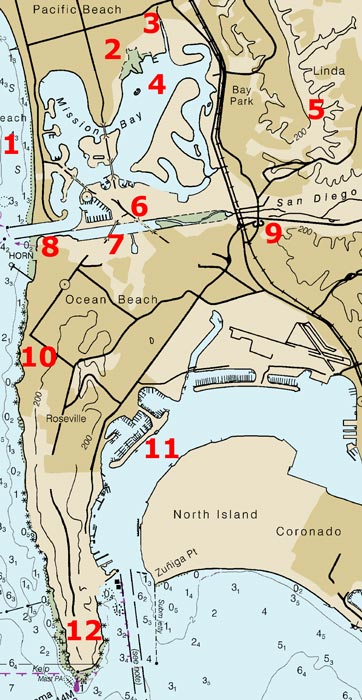
1 - Mission Beach
You can walk Mission Beach and north about a half dozen miles from the Mission Bay Channel to cliffs and headlands north of Tourmaline Beach on sand. The northern part is sand beach below sandstone cliffs, to the south houses are built on the sand bar separating the Pacific Ocean from Mission Bay. A concrete boardwalk runs most of the length of the beach. To the east of the boardwalk is housing. The beaches are used by people for surf play. Birds wade in the surf to hunt fish and sand critters.
2 - UCSD Kendall-Frost Marsh
One of just a few areas in Mission Bay that are still mud flats, as the entire bay was once. There is no public access, and a tall chain link fence obscures the line of sight, so you can't see much. But many birds hunt and nest there.
3 - Rose Creek
Paths on both sides allow one to see the transition from freshwater creek to tidal and then deeper saltwater. Many birds hunt in the transition zones. Rose Creek drains 23,427 acres in Scripps ranch, Mira Mesa, Kearny Mesa, La Jolla, Pacific Beach, Clairemont, and University City
4 - Mission Bay Park
To walk entirely around Mission Bay is about a dozen miles on concrete sidewalks, but there are restaurants and stores to keep you supplied. Many birds hunt in the mud during receding tides. Others visit picnics hoping for handouts. The San Diego River Delta once included all of present Mission Bay through all of the lowlands separating Point Loma and Old Town. The river would alternately drain into San Diego Bay or present day Mission Bay, which was formerly a mud flat known since Spanish colonial days as False Bay. Starting in 1852, various dikes were built to keep the San Diego River from emptying into San Diego Bay. From the late 1940s through the 1960s, some mudflats were dredged to form channels, while others were filled with the spoil to form dry land. The resulting 4,235 acre city park is 54% water, with the balance being grass and sandy beaches. Of 27 miles of shoreline, 19 are sand beach.
5 - Tecolote Canyon
Tecolote canyon has a nature/visitor center. It is typical of many canyons in San Diego in not being developed with houses. The canyons have service roads for sewers, etcetera, on which one can hike, but are otherwise left wild (coastal chaparral). Creeks flow mostly after rains, and are sometimes contaminated by urban runoff or overflowing sanitary sewers.
6 - San Diego River channel
To the west, the channel shown in blue is mostly too deep for wading birds. Ducks and other diving birds hunt here for plants and fish. To the east, mudflats and grasslands attract many birds. Near the freeway and railroad, trees and brush start. These brushy areas are popular as campsites for homeless people, and are too trashed to be very attractive for walking. Paved paths run on both sides of the channel from the ocean to beyond the freeway and tracks, but the eastern end is less attractive due to freeway noise and trash. On the south side, the paved path extends to a baseball park north of the faux mission buiding on the hill at 9. There may someday be a continuous riverside path to the source of the San Diego River in the Cuyamaca Mountains. See www.sandiegoriver.org.
7 - Famosa Slough
Tidally flushed mudflats popular with wading birds and ducks. Paths partway around allow a good line of sight while letting shy birds feed away from people, dogs, etcetera. A 12 acre channel area between Interstate 8 and West Point Loma Boulevard is favored by herons and egrets. The channel flows with each tide and flushes the mudflats to the south. Crossing the channel is an historic trestle for the #14, 15, and 16 streetcar that ran from downtown to Ocean Beach and La Jolla from May 1924 until September 1940. A 25 acre tidally flushed mudflat is south of West Point Loma Boulevard. It is favored by shorebirds, wading birds, and ducks. Several ponds impound urban runoff, reducing sediment and trash flow into the mudflats.
8 - Ocean Beach
Part of the San Diego River's mouth is a dog beach; part is a bird preserve. But people let their dogs run into the preserve, so it's a second rate place for birds. On a receding tide, birds who probe in sand for food favor the area. There is a public pier with good views.
9 - Spanish Presidio Site
Next to the faux mission buiding on the hill is the first Spanish settlement, the Presidio. There are no standing buildings, but there are interpretive signs, and often signs of an archaeological dig. The mission was first located here because ships coming north or south along the coast could be seen, and there was access to the San Diego River for water and agriculture. The mission soon moved several miles upriver for agricultural reasons.
10 - Sunset Cliffs
Sandstone cliffs by houses and roads. Pocket sand beaches and tidepool areas. Rocky headlands, views, and birds.
11 - Shelter Island
Artificial peninsula surrounded by riprap and docks. Some birds and Harbor Seals.
12 - Cabrillo National Monument
Tidepools, Hiking in Coastal Chaparral, Historic Lighthouse and WWI and WWII bunkers, Visitor Center, Views of Downtown and the Pacific Ocean.
|
American White Pelicans Pelecanus erythrorhynchos on San Diego River Sandbar
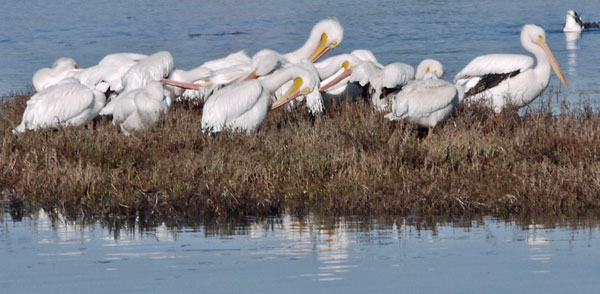
Brown Pelican Pelecanus occidentalis on Ocean Beach Pier
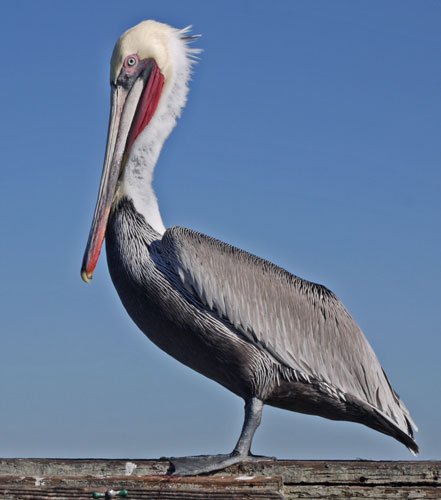
Brown Pelican Pelecanus occidentalis Swimming
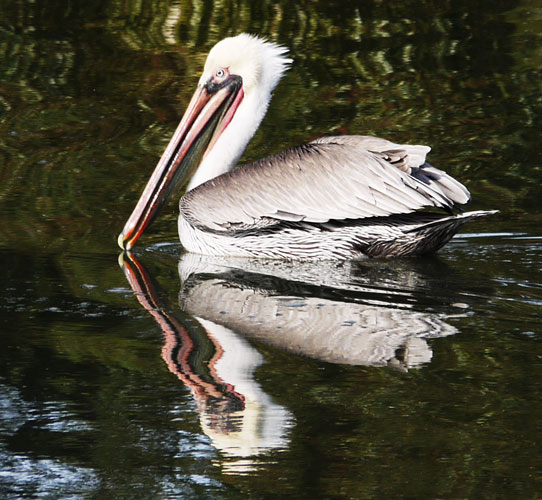
Brown Pelicans dive for fish, whereas American White Pelicans hunt while swimming, and may cooperated to herd prey. American White Pelicans nest near inland lakes, and during the breeding season, both males and females develop a bump atop their beaks.
American Wigeons Anas americana in Famosa Slough
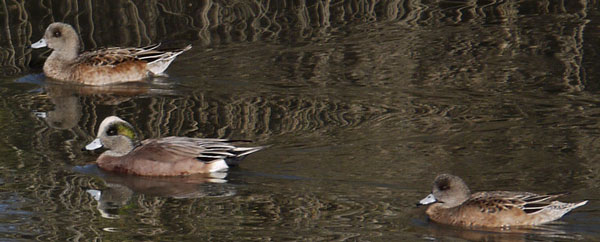
Mudbar with Redheads, American Wigeons, and Cormorants
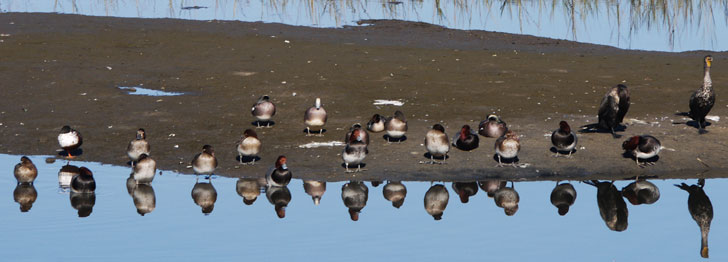
Mallards Anas platyrhynchos in Famosa Slough

Redhead Aythya americana and Lesser Scaup Aythya affinis
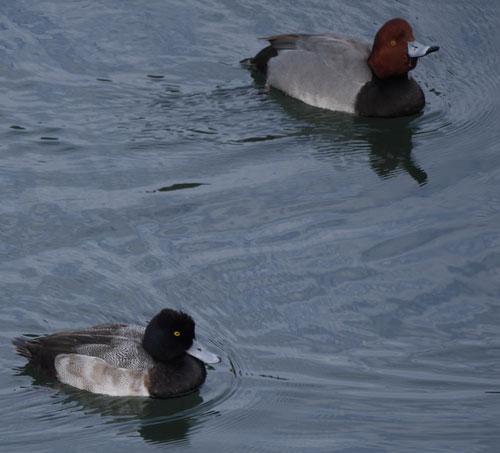
Western Grebes Aechmophorus occidentalis
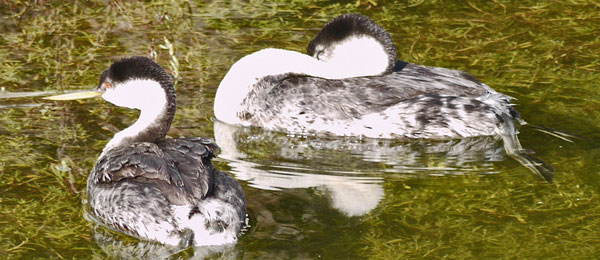
Western Grebe feet
Flattened toes, like Coots, but not lobed.
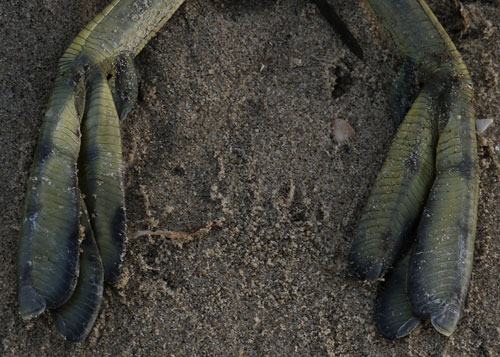
|
American Coot Fulica americana
 Coot perched on Rip Rap of Levee of San Diego River.
Coot perched on Rip Rap of Levee of San Diego River.
There are many Coots swimming in the river channel.
|
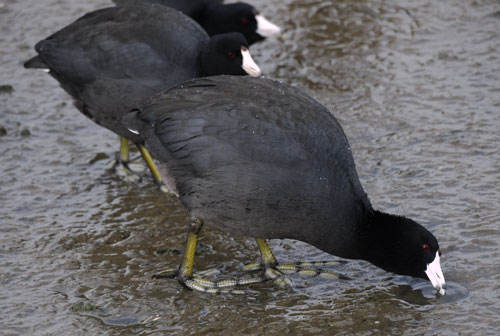 On a receding tide in Mission Bay, American Coots carefully examine each hole in wet sand left by potential prey or other hunting birds.
On a receding tide in Mission Bay, American Coots carefully examine each hole in wet sand left by potential prey or other hunting birds.
|
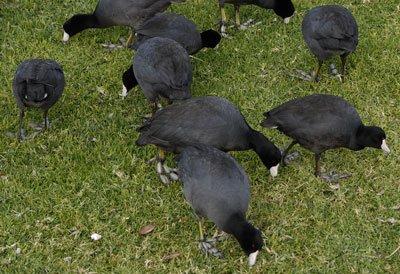 On the east side of Mission Bay, vast flocks of American Coots eat the park lawn grass. They are quite used to park visitors. People can approach them within about 15 feet before they walk away, but if you stand still, even while manipulating a camera, flocks may completely surround and ignore you.
On the east side of Mission Bay, vast flocks of American Coots eat the park lawn grass. They are quite used to park visitors. People can approach them within about 15 feet before they walk away, but if you stand still, even while manipulating a camera, flocks may completely surround and ignore you.
|

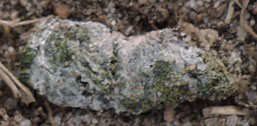 After eating vast quantities of lawn grass, the Coots leave these green scat piles everywhere.
After eating vast quantities of lawn grass, the Coots leave these green scat piles everywhere.
|
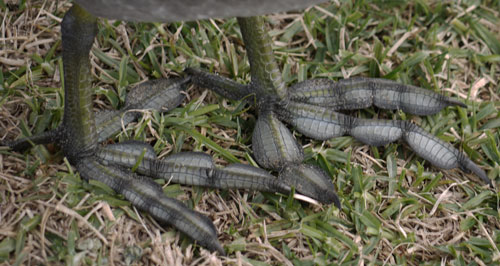
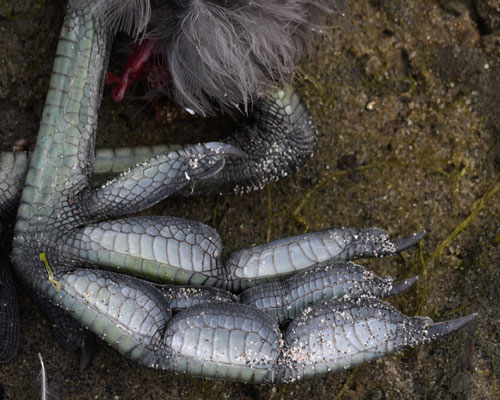 Coots have unique flattened toes lobed at each joint. The toes can flatten on the swimming thrust stroke for extra purchase and streamline into a V shape for the return stroke.
Coots have unique flattened toes lobed at each joint. The toes can flatten on the swimming thrust stroke for extra purchase and streamline into a V shape for the return stroke.
|
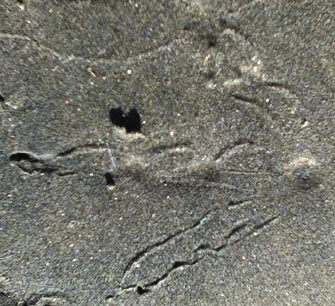
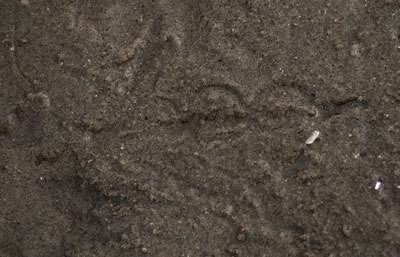 When walking on soft soils, the large surface area keeps them from sinking. Only a rare, extra soft, soil is compressed enough to make a foot print. But that print, with toe lobes, is unique to Coots.
When walking on soft soils, the large surface area keeps them from sinking. Only a rare, extra soft, soil is compressed enough to make a foot print. But that print, with toe lobes, is unique to Coots.
|
|
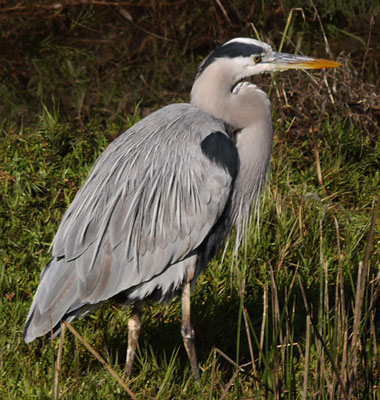
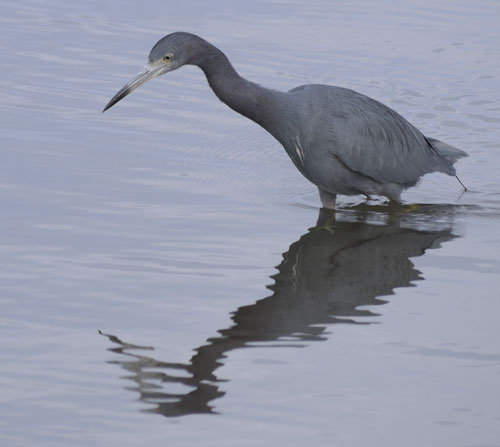 ← Great Blue Heron Ardea herodias
← Great Blue Heron Ardea herodias
→ Little Blue Heron Egretta caerulea
|
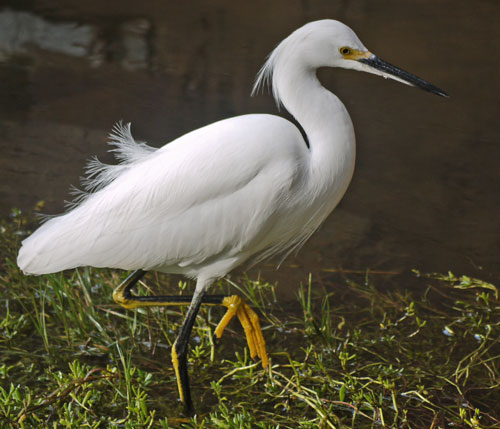
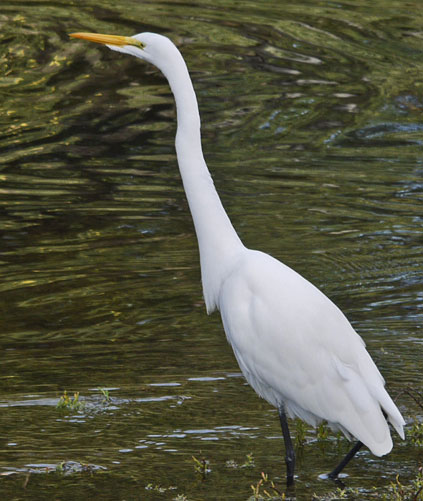 ← Snowy Egret Egretta thula
← Snowy Egret Egretta thula
→ Great Egret Casmerodius albus
There are a few other Egrets and Herons who show up occasionally, but these four pictures are of the common ones.
|
Great Blue Herons are about twice as heavy as Great Egrets Ardea alba, but only a little taller. The bill of a Great Blue Heron is usually dull yellow, becoming more orange briefly at the start of the breeding season. The lower legs are normally gray, but more orange at the start of the breeding season.
Adult Little Blue Herons have grey-blue bills, feathers, and legs. The neck is purple in breeding adults. Young (first year) birds are white except for dark wingtips and dull green legs. White / young Little Blue Herons often group with Snowy Egrets as they are more tolerant than adult colored Little Blue Herons. Also, they may be less apparent to predators when mingled with similar colored egrets.
Snowy Egrets have a yellow (red in breeding season) area between the eyes and black bill. The legs are black and the feet yellow. In juveniles, the bottom of the beak is light colored, and the back of the legs is yellow or green.

→ Burrowing Owl Speotyto cunicularia
Burrowing Owls live in the riprap levees of the San Diego River channel. They perch on and observe from the taller riprap rocks, perhaps a couple feet higher than average. Even if they're gone, white scat around a big rock is a hint that they live nearby.
Squirrels and Belted Kingfishers Ceryle alcyon also live in the levee riprap, so the soil must be good for burrowing, and there are probably many existing tunnels to renovate for new homes.
Locally, Burrowing Owls and Belted Kingfishers each perch and observe their surroundings for prey, but the owls are usually 2-3' off the ground, like on a rock, and the Kingfishers perhaps 7', like on a chain link fencepost, so they can be distinguished by perching behaviour from a distance. Their shapes are also different.
|
Squirrel
San Diego River levee riprap

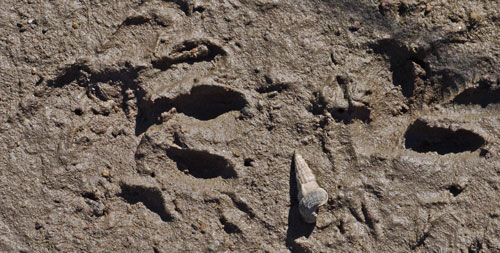
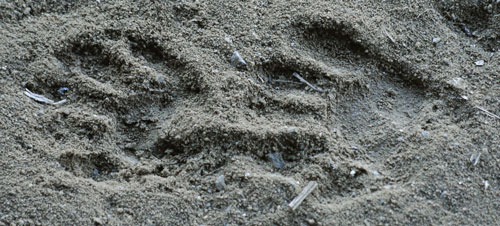 ↔ Raccoon Prints Procyon lotor
↔ Raccoon Prints Procyon lotor
← in Famosa Slough mud
→ under bridge
On the left, the prints are in slimy organic, clay, and sand mud. Note smearing and bird prints. On the right, the prints are in sand under a bridge over the San Diego River channel. No rain or sun ever hits the sand, and it is always humid. Over time, the sand builds a poofy texture that will take tracks of almost anything.
|
Black Necked Stilt Himantopus mexicanus
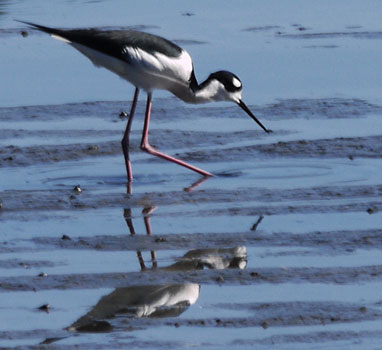
Lesser Yellowlegs Tringa flavipes

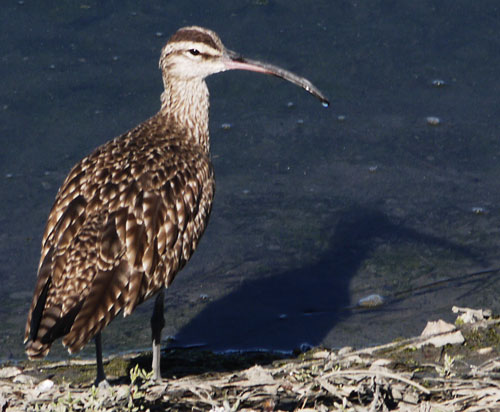
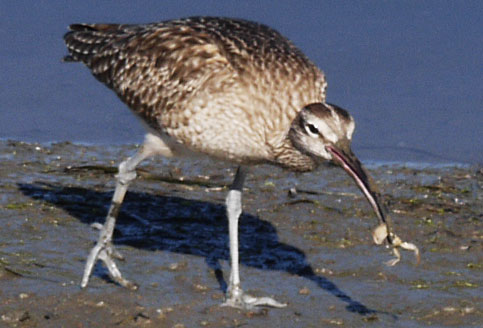 ↔ Long Billed Curlew Numenius americanus
↔ Long Billed Curlew Numenius americanus
← Long Billed Curlew
→ Long Billed Curlew Eating Crab
|
Marbled Godwit Limosa fedoa
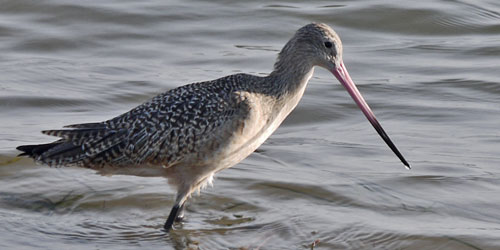
Willet Catoptrophorus semipalmatus
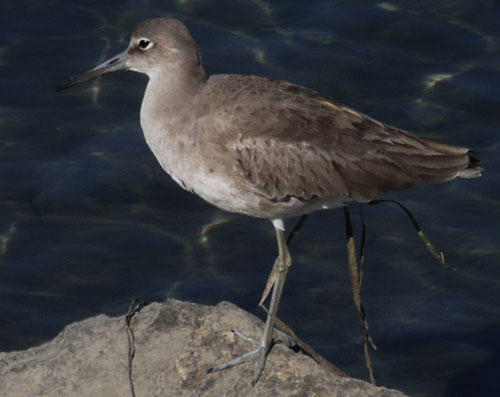
Mourning Dove Zenaida macroura
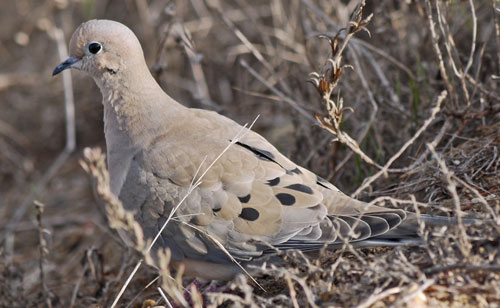
Pigeon or Rock Dove Columba livia

Anna's Hummingbird Calypte anna
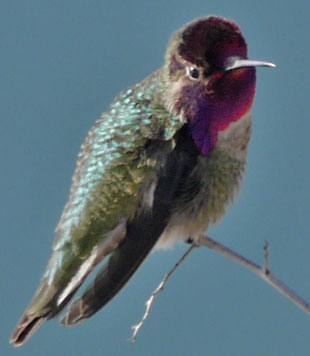
Western Gull Larus occidentalis
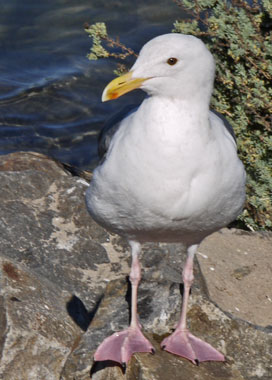
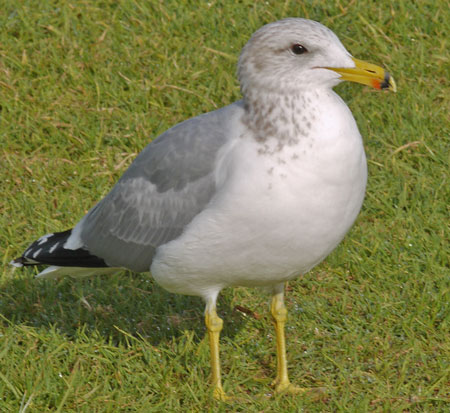
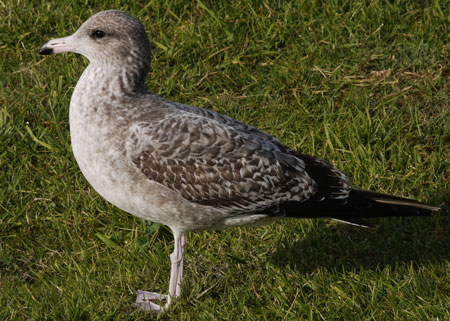 ↔ California Gull Larus californicus
↔ California Gull Larus californicus
← Breeding Colors
→ First Winter / Camoflage Colors
One difficulty in identifying birds is that they change colors and feathers over their lifetimes and over a year to be more noticable for breeding and more camoflaged when not breeding.
|
Western Gulls stay near the Pacific Ocean year round and nest on islands, etcetera.
California Gulls migrate to the Pacific Coast in winter, but typically breed at lakes as far east at Utah. Mono Lake is one breeding area. Recently, California Gulls have begun breeding in south San Francisco Bay.
Double Crested Cormorant Phalacrocorax auritus
Juvenile Bland Coloration

Sunset Cliffs Sea Stack with Cormorants, Brown Pelicans, and Gulls

Old Trolley Trestle in Famosa Slough

Leroy, Don, and me (Dan), Sunday breakfast by Rose Creek
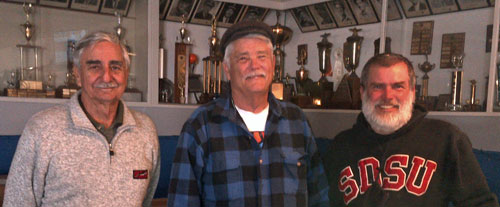










 Coot perched on Rip Rap of Levee of San Diego River.
Coot perched on Rip Rap of Levee of San Diego River. On a receding tide in Mission Bay, American Coots carefully examine each hole in wet sand left by potential prey or other hunting birds.
On a receding tide in Mission Bay, American Coots carefully examine each hole in wet sand left by potential prey or other hunting birds.
 On the east side of Mission Bay, vast flocks of American Coots eat the park lawn grass. They are quite used to park visitors. People can approach them within about 15 feet before they walk away, but if you stand still, even while manipulating a camera, flocks may completely surround and ignore you.
On the east side of Mission Bay, vast flocks of American Coots eat the park lawn grass. They are quite used to park visitors. People can approach them within about 15 feet before they walk away, but if you stand still, even while manipulating a camera, flocks may completely surround and ignore you.

 After eating vast quantities of lawn grass, the Coots leave these green scat piles everywhere.
After eating vast quantities of lawn grass, the Coots leave these green scat piles everywhere.

 Coots have unique flattened toes lobed at each joint. The toes can flatten on the swimming thrust stroke for extra purchase and streamline into a V shape for the return stroke.
Coots have unique flattened toes lobed at each joint. The toes can flatten on the swimming thrust stroke for extra purchase and streamline into a V shape for the return stroke.

 When walking on soft soils, the large surface area keeps them from sinking. Only a rare, extra soft, soil is compressed enough to make a foot print. But that print, with toe lobes, is unique to Coots.
When walking on soft soils, the large surface area keeps them from sinking. Only a rare, extra soft, soil is compressed enough to make a foot print. But that print, with toe lobes, is unique to Coots.

 ← Great Blue Heron Ardea herodias
← Great Blue Heron Ardea herodias
 ← Snowy Egret Egretta thula
← Snowy Egret Egretta thula


 ↔ Raccoon Prints Procyon lotor
↔ Raccoon Prints Procyon lotor


 ↔ Long Billed Curlew Numenius americanus
↔ Long Billed Curlew Numenius americanus






 ↔ California Gull Larus californicus
↔ California Gull Larus californicus


